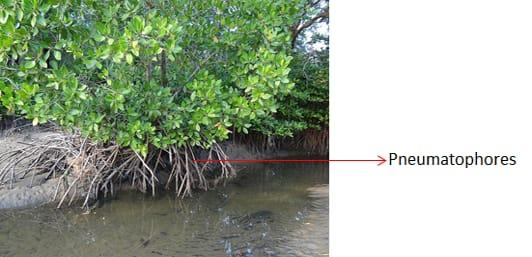
What are pneumatophores?
Answer
582.3k+ views
Hint: Different parts of the plant i.e. leaves, stem, and root undergo several modifications in order to adapt to the surrounding environment.
Complete answer:
Pneumatophores are the specialized erect roots (a modification of root) which facilitate the exchange of gases in plants growing in marshy areas. So, the pneumatophores are also called, breathing roots as these roots possess pores known as breathing pores or pneumatophores for gaseous exchange. The plants having pneumatophores are Mangrove, Avicennia, Sonneratia, etc.
Additional Information: In some plants, the roots modify their shape and structure to accomplish functions other than transportation.
Modifications of Tap Roots:
-Storage modification- In some plants, the roots become fleshy by absorbing the food material. Examples- carrot, radish, turnip, etc.
-Respiratory modification- In some halophytes (plants growing in the salty, swampy environment) the roots emerge out of the ground and grow upwards to get oxygen for respiration. Their root tips possess minute pores called lenticels through which aid in respiration. Example- Rhizophora, etc.
-Nodulated Roots- Roots of the leguminous plants are modified into root nodules that contain nitrogen-fixing bacteria such as Rhizobium. They help in fixing the atmospheric nitrogen into nitrates and make it available to the plant.
Modifications of Adventitious root:
-Prop Roots: These roots, also known as hanging roots, develop from the main branches of the tree and penetrate into the ground thereby providing support to the tree. Example- banyan tree.
-Stilt Roots: These roots come out obliquely from the basal node of the stem to aid in anchorage. Example- sugarcane.
-Climbing Roots: These roots arising from the nodes attach themselves to the nearby support to climb over it. Thus they provide support to the plant. Example- Money plant, etc.
-Buttress Roots: These are vertically elongated structures originating from the base of the stem which spread in different directions in the soil. Example- Bombax.
Note: The pneumatophores in Avicennia and Sonneratia species are the side branches of the horizontal roots which grow erectly just below the soil. In Avicennia, they are pencil-like and grow up to only 30 cm tall, whereas in Sonneratia, they become woody and may even reach 3 m in height.

Complete answer:
Pneumatophores are the specialized erect roots (a modification of root) which facilitate the exchange of gases in plants growing in marshy areas. So, the pneumatophores are also called, breathing roots as these roots possess pores known as breathing pores or pneumatophores for gaseous exchange. The plants having pneumatophores are Mangrove, Avicennia, Sonneratia, etc.
Additional Information: In some plants, the roots modify their shape and structure to accomplish functions other than transportation.
Modifications of Tap Roots:
-Storage modification- In some plants, the roots become fleshy by absorbing the food material. Examples- carrot, radish, turnip, etc.
-Respiratory modification- In some halophytes (plants growing in the salty, swampy environment) the roots emerge out of the ground and grow upwards to get oxygen for respiration. Their root tips possess minute pores called lenticels through which aid in respiration. Example- Rhizophora, etc.
-Nodulated Roots- Roots of the leguminous plants are modified into root nodules that contain nitrogen-fixing bacteria such as Rhizobium. They help in fixing the atmospheric nitrogen into nitrates and make it available to the plant.
Modifications of Adventitious root:
-Prop Roots: These roots, also known as hanging roots, develop from the main branches of the tree and penetrate into the ground thereby providing support to the tree. Example- banyan tree.
-Stilt Roots: These roots come out obliquely from the basal node of the stem to aid in anchorage. Example- sugarcane.
-Climbing Roots: These roots arising from the nodes attach themselves to the nearby support to climb over it. Thus they provide support to the plant. Example- Money plant, etc.
-Buttress Roots: These are vertically elongated structures originating from the base of the stem which spread in different directions in the soil. Example- Bombax.
Note: The pneumatophores in Avicennia and Sonneratia species are the side branches of the horizontal roots which grow erectly just below the soil. In Avicennia, they are pencil-like and grow up to only 30 cm tall, whereas in Sonneratia, they become woody and may even reach 3 m in height.

Recently Updated Pages
The number of solutions in x in 02pi for which sqrt class 12 maths CBSE

Write any two methods of preparation of phenol Give class 12 chemistry CBSE

Differentiate between action potential and resting class 12 biology CBSE

Two plane mirrors arranged at right angles to each class 12 physics CBSE

Which of the following molecules is are chiral A I class 12 chemistry CBSE

Name different types of neurons and give one function class 12 biology CBSE

Trending doubts
One Metric ton is equal to kg A 10000 B 1000 C 100 class 11 physics CBSE

Explain zero factorial class 11 maths CBSE

What is 1s 2s 2p 3s 3p class 11 chemistry CBSE

Discuss the various forms of bacteria class 11 biology CBSE

State the laws of reflection of light

An example of chemosynthetic bacteria is A E coli B class 11 biology CBSE




